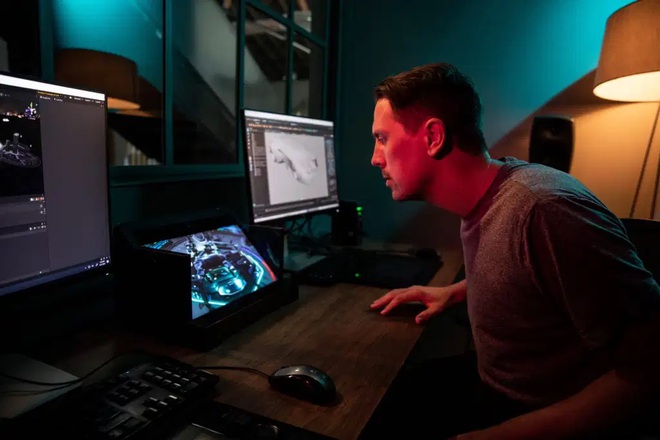Sony introduced the Spatial Reality Display, a 4K display capable of 3D viewing without glasses
- Tram Ho
Volumetric displays are not easy to manufacture, and they’re not that popular either, because rendering holographic images often involves a combination of stereoscopic technology and optical components. At times even high-speed eye-tracking technology is included.
However, that hasn’t stopped display experts at Sony from trying out a new product called ELF-SR1 – also known as the Spatial Reality Display – a type of monitor aimed at specialized users. industry in the field of content creation, and in the near future, it will be widely disseminated to ordinary consumers.
Designed to look like a traditional computer monitor, housed in a triangular frame with 45-degree reclining, the Spatial Reality Display combines a 15.6-inch display with an optical micro-lens coating and a camear followed her eyes. Although this screen has 4K resolution, in reality, the pixels are divided equally into 2K streams to target your left and right eye, using real-time pupil tracking data, and key alignment. pinpoint micro-lenses onto pixels for sharp, true-to-life 3D images. As a result, we get digital 3D objects that appear to be floating on the screen, and as you move your head or eyes, they also smoothly change their angle accordingly.
In other words, imagine a computer-generated hologram that appears in real life and viewable from any angle you want – that’s what Sony promises to deliver. In addition to being quite small, just equal to today’s laptop screens, the only downside is that the volumetric image is only optimal for one viewer at a time.
A similar technology that has appeared on consumer devices can be found in the Nintendo 3DS, but it obviously has a much lower resolution and also causes headaches for viewers. because of the lack of coordination of eye-tracking technology. Sony’s display has 40 times more pixels, and it also has the ability to independently track the viewer’s pupil position on 3 axes – top / bottom, left / right, and front / back – in time interval in milliseconds, allowing the monitor to properly fine-tune and render what viewers need to see in real time. A “powerful” Windows computer running Unity or the Unreal Engine is the only requirement to be able to actually create the aforementioned 3D content; in the future, Mac will also be supported.
Right now, Sony’s target audience of Spatial Reality Display are content creators in the 3D computer graphics field, including filmmakers and animation experts (like the Ghostbusters team. : Afterlife at Sony Pictures), car product designers, architects, and VR / AR content creators. 3D models and environments can be previewed in volumetric and realistic terms, allowing creators to fine-tune the lighting, position of objects, and check if any angle of rotation is blocked. before finishing the scenes or not.

Sony expects film pre-visualization to be one of the main uses of this technology in the future. Another application of the Spatial Reality Display will be in the car sales, allowing customers to review actual custom car models without having to “touch them with their own hands and eyes”. Compared to 2D monitors, the pure specs of the ELF-SR1 aren’t really that appealing – 500 nits of brightness, 1,400: 1 contrast, and support for approximately 100% Adobe RGB color gamut, same refresh rate. hasn’t been revealed yet – but Sony is confident that users will be amazed when they witness the 3D effects for themselves. The new Sony screen comes with 2.1 speakers and can be paired with additional accessories like a Leap Motion gesture controller for input, or a special box made by Sony to hold content and block out the light. projected environment, affecting display performance.
The Spatial Reality Display ELF-SR1 will sell for $ 5,000, a price similar to rival products from companies like Looking Glass. It will go on sale in November 2020 and can be ordered directly from the Sony website.
Reference: VentureBeat
Source : Genk
